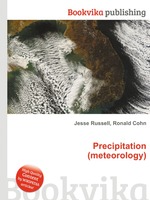Precipitation (meteorology)
Jesse Russell Ronald Cohn
бумажная книга
High Quality Content by WIKIPEDIA articles! In meteorology, precipitation (also known as one of the classes of hydrometeors, which are atmospheric water phenomena is any product of the condensation of atmospheric water vapor that falls under gravity. The main forms of precipitation include drizzle, rain, sleet, snow, graupel and hail. It occurs when a local portion of the atmosphere becomes saturated with water vapour and the water condenses. Two processes, possibly acting together, can lead to air becoming saturated: cooling the air or adding water vapour to the air. Generally, precipitation will fall to the surface; an exception is Virga which evaporates before reaching the surface. Precipitation forms as smaller droplets coalesce via collision with other rain drops or ice crystals within a cloud. Rain drops range in size from oblate, pancake-like shapes for larger drops, to small spheres for smaller drops. Unlike raindrops, snowflakes grow in a variety of different shapes and patterns, determined by the temperature and humidity characteristics of the air the snowflake moves through on its way to the ground. While snow and ice pellets require temperatures close to the ground to be near or below freezing, hail can occur during much warmer temperature regimes due to the process of its formation.


